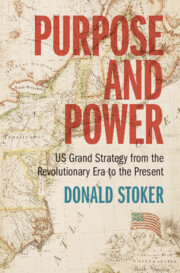Book contents
- Purpose and Power
- Purpose and Power
- Copyright page
- Dedication
- Contents
- Figures
- Maps
- Abbreviations
- Thinking about Grand Strategy in Peace and War
- Part I From Backwater to Great Power
- 1 The Fight for Sovereignty, 1775–1801
- 2 Expansion, Sovereignty, and War, 1801–1817
- 3 Seeking a Continent: Expansion, Indian Removal, and the Mexican War, 1817–1849
- 4 Schism, Civil War, and Reconstruction, 1849–1877
- 5 Conquering a Continent: The Indian wars, 1865–1897
- 6 American Empire, 1897–1913
- Part II From Great Power to Superpower
- Part III The Post–Cold War World
- Part IV Retreat and Defeat
- Acknowledgements
- Notes
- Index
4 - Schism, Civil War, and Reconstruction, 1849–1877
from Part I - From Backwater to Great Power
Published online by Cambridge University Press: 11 January 2024
- Purpose and Power
- Purpose and Power
- Copyright page
- Dedication
- Contents
- Figures
- Maps
- Abbreviations
- Thinking about Grand Strategy in Peace and War
- Part I From Backwater to Great Power
- 1 The Fight for Sovereignty, 1775–1801
- 2 Expansion, Sovereignty, and War, 1801–1817
- 3 Seeking a Continent: Expansion, Indian Removal, and the Mexican War, 1817–1849
- 4 Schism, Civil War, and Reconstruction, 1849–1877
- 5 Conquering a Continent: The Indian wars, 1865–1897
- 6 American Empire, 1897–1913
- Part II From Great Power to Superpower
- Part III The Post–Cold War World
- Part IV Retreat and Defeat
- Acknowledgements
- Notes
- Index
Summary
Mexican War success fed the Sectional Crisis related to slavery’s extension. The Zachary Taylor, Millard Fillmore, Franklin Pierce, and James Buchanan administrations are examined. Expansion remained an aim, and the Compromise of 1850 temporarily defused the sectional timebomb. America began developing deep relations with Asia, both economic and political. Buchanan failed to thwart Southern secession, which began after Abraham Lincoln’s election. The Confederacy, led by Jefferson Davis, fought for independence. Lincoln fought to preserve the Union but later made emancipation of the slaves a political aim. The Confederacy’s first strategy was a cordon defense. It moved to concentration, an offensive strategy, and a defensive strategy, accompanied by a self-imposed cotton embargo. The Union considered Winfield Scott’s Anaconda Plan, implemented a blockade of the South, applied simultaneous pressure under George McClellan and Henry Wager Halleck, later adding destruction of Southern resources and industry. Ulysses S. Grant and William Tecumseh Sherman applied simultaneous pressure and attrition against the forces of Robert E. Lee, Joseph Johnston, and other Confederates to break the South’s armies and subdue it. Union efforts at Reconstruction under Andrew Johnson followed. These produced mixed results and contributed to Johnson’s impeachment. Reconstruction ended in 1877 under Rutherford B. Hayes.
Keywords
- Type
- Chapter
- Information
- Purpose and PowerUS Grand Strategy from the Revolutionary Era to the Present, pp. 118 - 155Publisher: Cambridge University PressPrint publication year: 2024



